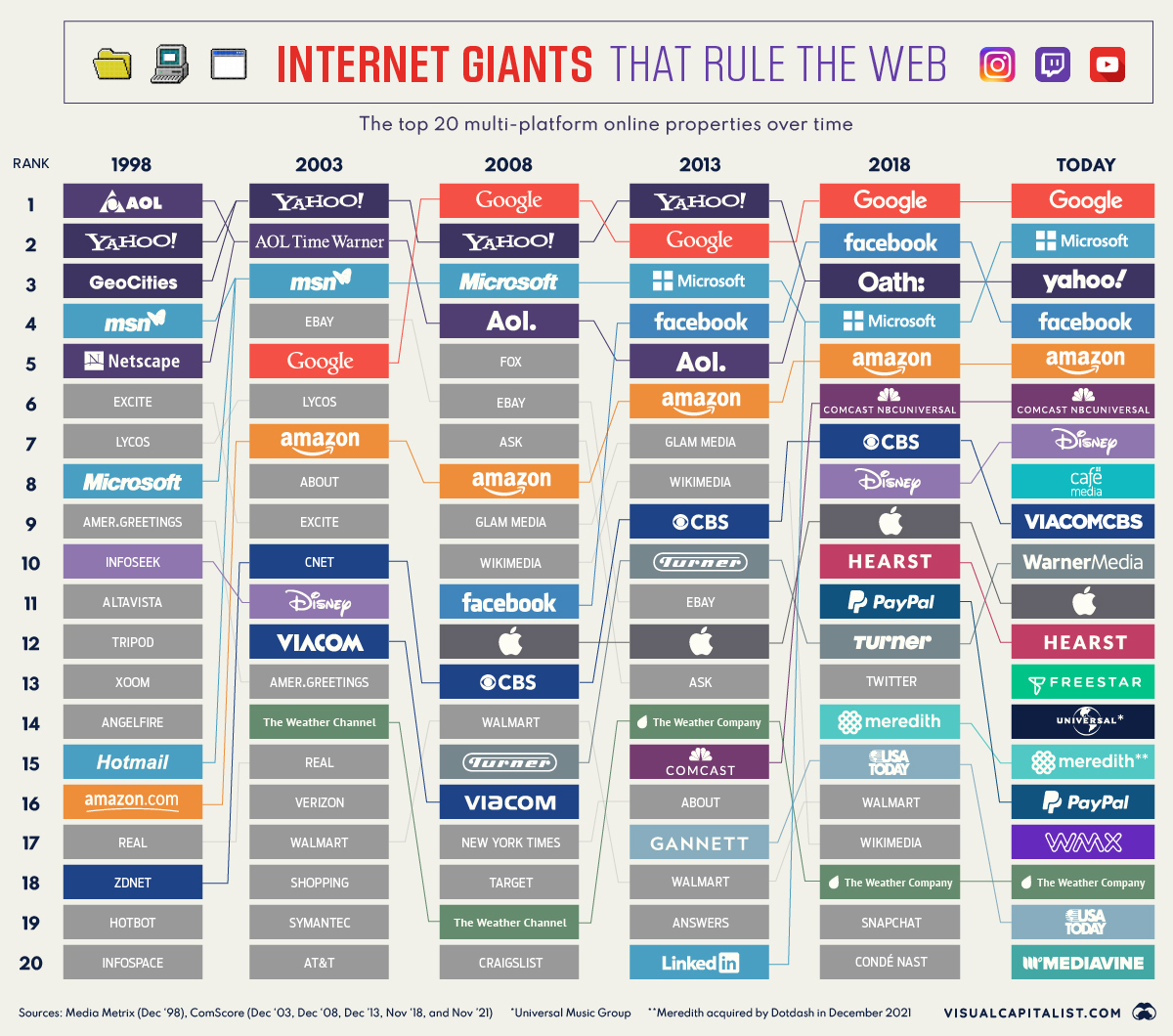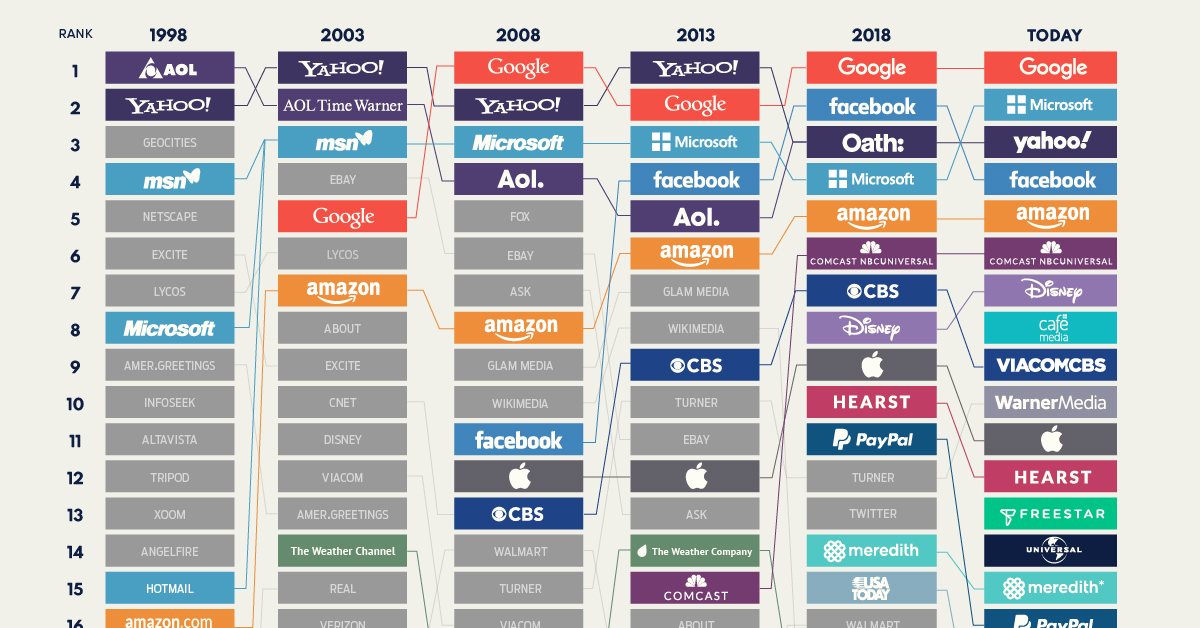Technology
The 20 Internet Giants That Rule the Web

The 20 Internet Giants That Rule the Web (1998-Today)
With each passing year, an increasingly large segment of the population no longer remembers images loading a single pixel row at a time, the earsplitting sound of a 56k modem, or the early domination of web portals.
Many of the top websites in 1998 were news aggregators or search portals, which are easy concepts to understand. Today, brand touch-points are often spread out between devices (e.g. mobile apps vs. desktop) and a myriad of services and sub-brands (e.g. Facebook’s constellation of apps). As a result, the world’s biggest websites are complex, interconnected web properties.
The visualization above, which primarily uses data from ComScore’s U.S. Multi-Platform Properties ranking, looks at which of the internet giants have evolved to stay on top, and which have faded into internet lore.
America Moves Online
For millions of curious people the late ’90s, the iconic AOL compact disc was the key that opened the door to the World Wide Web. At its peak, an estimated 35 million people accessed the internet using AOL, and the company rode the Dotcom bubble to dizzying heights, reaching a valuation of $222 billion dollars in 1999.
AOL’s brand may not carry the caché it once did, but the brand never completely faded into obscurity. The company continually evolved, finally merging with Yahoo after Verizon acquired both of the legendary online brands. Verizon had high hopes for the company—called Oath—to evolve into a “third option” for advertisers and users who were fed up with Google and Facebook.
Sadly, those ambitions did not materialize as planned. In 2019, Oath was renamed Verizon Media, and was eventually sold once again in 2021.
A City of Gifs and Web Logs
As internet usage began to reach critical mass, web hosts such as AngelFire and GeoCities made it easy for people to create a new home on the Web.
GeoCities, in particular, made a huge impact on the early internet, hosting millions of websites and giving people a way to actually participate in creating online content. If it were a physical community of “home” pages, it would’ve been the third largest city in America, after Los Angeles.
This early online community was at risk of being erased permanently when GeoCities was finally shuttered by Yahoo in 2009, but luckily, the nonprofit Internet Archive took special efforts to create a thorough record of GeoCities-hosted pages.
From A to Z
In December of 1998, long before Amazon became the well-oiled retail machine we know today, the company was in the midst of a massive holiday season crunch.
In the real world, employees were pulling long hours and even sleeping in cars to keep the goods flowing, while online, Amazon.com had become one of the biggest sites on the internet as people began to get comfortable with the idea of purchasing goods online. Demand surged as the company began to expand their offering beyond books.
Amazon.com has grown to be the most successful merchant on the Internet.
– New York Times (1998)
Digital Magazine Rack
Meredith will be an unfamiliar brand to many people looking at today’s top 20 list. While Meredith may not be a household name, the company controlled many of the country’s most popular magazine brands (People, AllRecipes, Martha Stewart, Health, etc.) including their sizable digital footprints. The company also owned a slew of local television networks around the United States.
After its acquisition of Time Inc. in 2017, Meredith became the largest magazine publisher in the world. Since then, however, Meredith has divested many of its most valuable assets (Time, Sports Illustrated, Fortune). In December 2021, Meredith merged with IAC’s Dotdash.
“Hey, Google”
When people have burning questions, they increasingly turn to the internet for answers, but the diversity of sources for those answers is shrinking.
Even as recently as 2013, we can see that About.com, Ask.com, and Answers.com were still among the biggest websites in America. Today though, Google appears to have cemented its status as a universal wellspring of answers.
As smart speakers and voice assistants continue penetrate the market and influence search behavior, Google is unlikely to face any near-term competition from any company not already in the top 20 list.
New Kids on the Block
Social media has long since outgrown its fad stage and is now a common digital thread connecting people across the world. While Facebook rapidly jumped into the top 20 by 2007, other social media infused brands took longer to grow into internet giants.
By 2018, Twitter, Snapchat, and Facebook’s umbrella of platforms were all in the top 20, and you can see a more detailed and up-to-date breakdown of the social media universe here.
A Tangled Web
Today’s internet giants have evolved far beyond their ancestors from two decades ago. Many of the companies in the top 20 run numerous platforms and content streams, and more often than not, they are not household names.
A few, such as Mediavine and CafeMedia, are services that manage ads. Others manage content distribution, such as music, or manage a constellation of smaller media properties, as is the case with Hearst.
Lastly, there are still the tech giants. Remarkably, three of the top five web properties were in the top 20 list in 1998. In the fast-paced digital ecosystem, that’s some remarkable staying power.
This article was inspired by an earlier work by Philip Bump, published in the Washington Post.
Technology
Charting the Next Generation of Internet
In this graphic, Visual Capitalist has partnered with MSCI to explore the potential of satellite internet as the next generation of internet innovation.

Could Tomorrow’s Internet be Streamed from Space?
In 2023, 2.6 billion people could not access the internet. Today, companies worldwide are looking to innovative technology to ensure more people are online at the speed of today’s technology.
Could satellite internet provide the solution?
In collaboration with MSCI, we embarked on a journey to explore whether tomorrow’s internet could be streamed from space.
Satellite Internet’s Potential Customer Base
Millions of people live in rural communities or mobile homes, and many spend much of their lives at sea or have no fixed abode. So, they cannot access the internet simply because the technology is unavailable.
Satellite internet gives these communities access to the internet without requiring a fixed location. Consequently, the volume of people who could get online using satellite internet is significant:
| Area | Potential Subscribers |
|---|---|
| Households Without Internet Access | 600,000,000 |
| RVs | 11,000,000 |
| Recreational Boats | 8,500,000 |
| Ships | 100,000 |
| Commercial Aircraft | 25,000 |
Advances in Satellite Technology
Satellite internet is not a new concept. However, it has only recently been that roadblocks around cost and long turnaround times have been overcome.
NASA’s space shuttle, until it was retired in 2011, was the only reusable means of transporting crew and cargo into orbit. It cost over $1.5 billion and took an average of 252 days to launch and refurbish.
In stark contrast, SpaceX’s Falcon 9 can now launch objects into orbit and maintain them at a fraction of the time and cost, less than 1% of the space shuttle’s cost.
| Average Rocket Turnaround Time | Average Launch/Refurbishment Cost | |
|---|---|---|
| Falcon 9* | 21 days | < $1,000,000 |
| Space Shuttle | 252 days | $1,500,000,000 (approximately) |
Satellites are now deployed 300 miles in low Earth orbit (LEO) rather than 22,000 miles above Earth in Geostationary Orbit (GEO), previously the typical satellite deployment altitude.
What this means for the consumer is that satellite internet streamed from LEO has a latency of 40 ms, which is an optimal internet connection. Especially when compared to the 700 ms stream latency experienced with satellite internet streamed from GEO.
What Would it Take to Build a Satellite Internet?
SpaceX, the private company that operates Starlink, currently has 4,500 satellites. However, the company believes it will require 10 times this number to provide comprehensive satellite internet coverage.
Charting the number of active satellites reveals that, despite the increasing number of active satellites, many more must be launched to create a comprehensive satellite internet.
| Year | Number of Active Satellites |
|---|---|
| 2022 | 6,905 |
| 2021 | 4,800 |
| 2020 | 3,256 |
| 2019 | 2,272 |
| 2018 | 2,027 |
| 2017 | 1,778 |
| 2016 | 1,462 |
| 2015 | 1,364 |
| 2014 | 1,262 |
| 2013 | 1,187 |
Next-Generation Internet Innovation
Innovation is at the heart of the internet’s next generation, and the MSCI Next Generation Innovation Index exposes investors to companies that can take advantage of potentially disruptive technologies like satellite internet.
You can gain exposure to companies advancing access to the internet with four indexes:
- MSCI ACWI IMI Next Generation Internet Innovation Index
- MSCI World IMI Next Generation Internet Innovation 30 Index
- MSCI China All Shares IMI Next Generation Internet Innovation Index
- MSCI China A Onshore IMI Next Generation Internet Innovation Index
MSCI thematic indexes are objective, rules-based, and regularly updated to focus on specific emerging trends that could evolve.

Click here to explore the MSCI thematic indexes

-

 Technology1 week ago
Technology1 week agoCountries With the Highest Rates of Crypto Ownership
While the U.S. is a major market for cryptocurrencies, two countries surpass it in terms of their rates of crypto ownership.
-

 Technology2 weeks ago
Technology2 weeks agoMapped: The Number of AI Startups By Country
Over the past decade, thousands of AI startups have been funded worldwide. See which countries are leading the charge in this map graphic.
-

 Technology3 weeks ago
Technology3 weeks agoAll of the Grants Given by the U.S. CHIPS Act
Intel, TSMC, and more have received billions in subsidies from the U.S. CHIPS Act in 2024.
-

 Technology3 weeks ago
Technology3 weeks agoVisualizing AI Patents by Country
See which countries have been granted the most AI patents each year, from 2012 to 2022.
-

 Technology4 weeks ago
Technology4 weeks agoHow Tech Logos Have Evolved Over Time
From complete overhauls to more subtle tweaks, these tech logos have had quite a journey. Featuring: Google, Apple, and more.
-

 AI1 month ago
AI1 month agoRanked: Semiconductor Companies by Industry Revenue Share
Nvidia is coming for Intel’s crown. Samsung is losing ground. AI is transforming the space. We break down revenue for semiconductor companies.
-

 Personal Finance1 week ago
Personal Finance1 week agoVisualizing the Tax Burden of Every U.S. State
-

 Misc6 days ago
Misc6 days agoVisualized: Aircraft Carriers by Country
-

 Culture7 days ago
Culture7 days agoHow Popular Snack Brand Logos Have Changed
-

 Mining1 week ago
Mining1 week agoVisualizing Copper Production by Country in 2023
-

 Misc1 week ago
Misc1 week agoCharted: How Americans Feel About Federal Government Agencies
-

 Healthcare1 week ago
Healthcare1 week agoWhich Countries Have the Highest Infant Mortality Rates?
-

 Demographics1 week ago
Demographics1 week agoMapped: U.S. Immigrants by Region
-

 Maps1 week ago
Maps1 week agoMapped: Southeast Asia’s GDP Per Capita, by Country


















